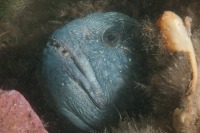
(Photo: Claire Goodwin)
Atlantic Wolffish
Anarhichas lupus
This fish is usually greyish blue to olive green in colour. It has a long body with a single dorsal fin running down most of its length. Atlantic wolffish have 10 or more dark bands marking the sides of their body, starting at the dorsal fin. They have a blunt snout with a fleshy mouth and prominent teeth. Can grow to up 1.5 metres long and 18 kilograms in weight.
Authority
Linnaeus, 1758
Classification Details
Phylum: Chordata (chordates); Subphylum: Vertebrata (vertebrates); Class: Actinopterygii (ray-finned fishes).
Habitat
Found on rocky substrate, from shallow waters down to depths of 500 metres. It is a cold-water fish preferring temperatures from 3°C to 6°C, although it can be found in waters up between -1°C and 10°C. Range in the western Atlantic is from southern Labrador to the Gulf of Maine, with occasional records off New Jersey. Also found in the eastern Atlantic including the North Sea, Faroe Islands, Barents Sea, and White Sea.
Diet
Predators. The wolffish mainly eats invertebrates such as sea stars, urchins, molluscs, and crabs. It is thought to control the density of species such as sea urchins. It also eats some fish, particularly redfish.
Reproduction
Sexes are separate. Adults move inshore into shallower waters to mate. Fertilization is internal and after 10 to 27 hours, the female lays the eggs in a hole in bedrock or under boulders. The eggs are up to six millimetres in diameter: some of the biggest fish eggs. Males guard the eggs and do not eat during this time. When larvae hatch, they remain close to the nest site. Wolffish reach sexual maturity around 10 years old and are known to live for at least 20 years.
Fun Facts
Wolffish often experience sub-zero temperatures during the winter. Because of this, their bodies produce antifreeze proteins. These proteins help inhibit the growth of ice crystals in their blood.
References
COSEWIC (2012) COSEWIC assessment and status report on the Atlantic Wolffish Anarhichas lupus in Canada. Committee on the Status of Endangered Wildlife in Canada. Ottawa. ix + 56 pp. (www.registrelep–sararegistry.gc.ca/default_e.cfm). Froese R and Pauly D (editors) (2019) FishBase. Anarhichas lupus Atlantic Wolffish. https://www.fishbase.se/summary/2501 Accessed online 18 January 2020. Johannessen T, Gjøsæter J and Moksness E (1993) Reproduction, spawning behaviour and captive breeding of the common wolffish Anarhichas lupus L. Aquaculture 115(1–2), 41–51. Keats D, South GR and Stelle GH (2011) Reproduction and egg guarding by Atlantic wolffish (Anarhichas lupus: Anarhichidae) and ocean pout (Macrozoarces americanus: Zoarcidae) in Newfoundland waters. Canadian Journal of Zoology 63(11), 2565–2568. Pavlov DA (1994) Fertilization in the wolffish, Anarhichas lupus: External or internal? Journal of Ichthyology 34(1), 140–151. Scott WB and Scott MG (1988) Atlantic fishes of Canada. Canadian Bulletin of Fisheries and Aquatic Sciences 219, 731p.

